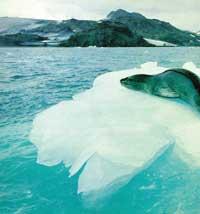Chlorine molecules from tropic islands to the atmosphere
2000/01/25 Roa Zubia, Guillermo - Elhuyar Zientzia

The atmosphere is not only composed of oxygen, nitrogen, carbon dioxide and water, as explained in textbooks. There are many other molecules, although they are divided into small concentrations. Among them are those containing chlorine and fluoride. This is due to the decrease in the ozone layer we have learned a few years ago. Where do these molecules come from?
Lately it has been seen that human production produces molecules called CFCs, each of which can destroy about 100,000 ozone molecules. The main sources of CFCs have been aerosols, propellers, some solvents, notches and creative foams, all created by humans. All this is true and due to the decrease in the ozone layer, agreements were made to avoid greater use of CFCs. But such molecules also exist in nature.
Main source of chlorine
The most abundant chlorinated molecule in the atmosphere is chlorine methane (CH 3 Cl). This is therefore the main source of chlorine atoms in the stratosphere. The estimated half-life of this molecule in the atmosphere is year and a half, as it reacts not only with ozone, but also with other substances. It is known that oceans and seas raise large amounts of this molecule. In fact, the main natural source was the emission of the seas. On the other hand, biomass combustion was also important. However, after the research, it has been understood that these two sources do not present the total amount of chlorine methane and have begun the search for new sources.
This week's specialized journal Nature has published the results of this search. This study was conducted by a Japanese group in collaboration with another from Canada. The laboratories are also located in privileged places: The tropical island of Okinawa and the village of Alert, in the North Pole. A ship in continuous transit between Japan and Canada took samples every two degrees of land latitude. Measurements were made from July 1996 to December 1998. Thus, the influence of seasonal change has also been analyzed. Concentrations of this molecule have been found with low falls in autumn and increases in spring.
In the latitudes of the tropics the concentration of chlorine methane is higher than in other areas. According to the researchers, in addition to what marine bioamasa emits to explain the discovered, we must think of terrestrial sources. Isolated land studies were also conducted in the Java and Jakarta islands. The concentration of methane chlorine was enormous. The source is the fungi that appear when the wood rots. According to scientists, in coastal plants it is higher than in indoor plants.
Multivariate system
It must therefore be accepted that atmospheric chlorine molecules are also emitted naturally. At least chlorine methane does. Scientists are waiting for other types of studies, such as the impact of climatology. In addition, the processes through which the transport of atmospheric substances occurs are unknown, which requires long research. The results, for the moment, have spread to all latitudes, but with such different conditions, will they be similar in other territories? In Europe, for example? It should be remembered that the measures have been taken in the area between Canada and Japan.

Gai honi buruzko eduki gehiago
Elhuyarrek garatutako teknologia





